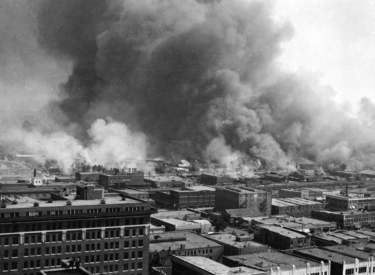A World War I veteran is first Tulsa Race Massacre victim identified from mass graves
The Associated Press - July 13, 2024 8:06 am

By KEN MILLER Associated Press
OKLAHOMA CITY (AP) — A World War I veteran is the first person identified from graves filled with more than a hundred victims of the 1921 Tulsa Race Massacre that devastated the city’s Black community, the mayor said on Friday.
Using DNA from descendants of his brothers, the remains of C.L. Daniel from Georgia were identified by Intermountain Forensics, said Mayor G.T. Bynum and officials from the lab. He was in his 20s when he was killed.
“This is one family who gets to give a member of their family that they lost a proper burial, after not knowing where they were for over a century,” Bynum said.
A white mob massacred as many as 300 Black people over the span of two days in 1921, a long-suppressed episode of racial violence that destroyed a thriving community known as Black Wall Street and ended with thousands of Black residents forced into internment camps overseen by the National Guard.
Brenda Nails-Alford, a descendant of massacre survivors and a member of the committee overseeing the search for victims, said the identification brought her to tears.
“This is an awesome day, a day that has taken forever to come to fruition,” Nails-Alford said.
More than 120 graves were found during searches that began in 2020, with forensic analysis and DNA collected from about 30 sets of remains. Daniel’s remains are the first from those graves to be linked directly to the massacre.
The breakthrough for identifying Daniel came when investigators found a 1936 letter from his mother’s attorney seeking veteran’s benefits. Alison Wilde, a forensic scientist with Salt Lake City-based Intermountain Forensics, said the letter provided by the National Archives convinced investigators that Daniel was killed in the massacre.
No members of Daniel’s family, many of whom don’t know each other, attended the news conference announcing the identification, which was made earlier this week, Wilde said.
“I think it’s shocking news, to say the least” for the family, Wilde said. “We know we’ve brought a lot into their lives”
The massacre began when a white mob, including some deputized by authorities, looted and burned Tulsa’s Greenwood District. More than 1,200 homes, businesses, schools, and churches were destroyed from May 31-June 1.
Forensic anthropologist Phoebe Stubblefield said Daniel’s remains were fragmented and a cause of death could not be determined.
“We didn’t see any sign of gunshot wounds, but if the bullet doesn’t hit bone or isn’t retained within the body, how would we detect it?”
Oklahoma state archaeologist Kary Stackelbeck said the remains that were exhumed, including Daniel, were found in simple wooden boxes — and Daniel’s was too small for him.
“They had to bend his legs somewhat at the knee in order to get him to fit,” Stackelbeck said. “His head and his feet both touched either end of the casket.”
Stackelbeck said investigators were searching for simple caskets because they were described in newspaper articles at the time, death certificates, and funeral home records as the type used for burials of massacre victims.
Bynum said the next search for victims will begin July 22.
“We’ll continue the search until we find everybody that we can,” Bynum said.
A lawsuit by the two known living survivors of the massacre was dismissed by the Oklahoma Supreme Court in June.
Attorneys for the two, Viola Fletcher, 110, and Lessie Benningfield Randle, 109, are asking the court to reconsider the decision. Attorneys are also asking the U.S. Department of Justice to open an investigation into the massacre under the Emmett Till Unsolved Civil Rights Crime Act of 2007, which allows for the reopening of cold cases of violent crimes against Black people committed before 1970.



